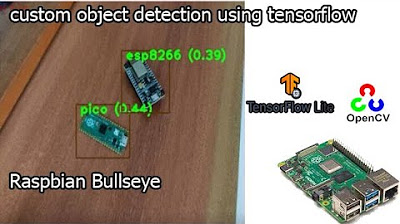Fire Detection YOLOv8 with Python (real time & custom data)
Summary
TLDRIn this tutorial, the speaker demonstrates how to create a YOLOv8 model for fire detection using pre-labeled datasets and Google Colab. The video covers the entire process, from downloading data to training the model, and evaluating its performance on static images and real-time video. Despite the model achieving only moderate results due to limited training time and data set diversity, the speaker suggests retraining the model with a larger dataset and more epochs to improve accuracy. This video serves as a great introduction to building a fire detection model with YOLOv8.
Takeaways
- 😀 The YOLOv8 model can be used to detect fire in images and videos with minimal setup.
- 😀 Data preparation is crucial, and pre-labeled datasets, like those from Roboo, make the process easier.
- 😀 Google Colab offers free GPU time, making it a convenient platform for training models.
- 😀 Installing necessary libraries like `allytics` and `roof flow` may be required depending on your data preparation method.
- 😀 The training process can be set up with just a few lines of code, specifying architecture and number of epochs.
- 😀 The small YOLOv8 model is faster but may offer lower accuracy compared to larger models.
- 😀 Training the model for a longer duration (e.g., 80 epochs) improves its accuracy significantly.
- 😀 Plots generated during training provide valuable insights into the model's progress and help decide if further training is necessary.
- 😀 After training, the model is saved as a `.pt` file, which can be used for making predictions.
- 😀 The model can be tested with static images, but real-time fire detection requires configuring the model to work with live camera feeds.
- 😀 For better model performance, using a larger dataset and longer training times will improve generalization and accuracy.
Q & A
What is the purpose of the script presented in the video?
-The script demonstrates how to create and train a YOLOv8 model to detect fire in images or videos, focusing on simplifying the process through data preparation and model training.
Why is data preparation crucial for training a YOLOv8 model?
-Data preparation is critical because the quality and accuracy of the model's performance depend on the labeled dataset. The script highlights using pre-labeled datasets, like the one from RoboO, which simplifies the process significantly.
How does the script simplify the data labeling process?
-Instead of labeling the images manually, the script uses a pre-labeled dataset from RoboO, which contains around 12,000 images with bounding boxes already drawn, saving time and effort.
What is the role of Google Colab in the training process?
-Google Colab is used to run the training script with GPU acceleration, offering free GPU resources for faster model training, which is ideal for those without access to expensive hardware.
What are the libraries needed to run the script?
-The script requires the installation of two libraries: 'allytics' and 'roof flow,' which help in preparing the data and interacting with the model training environment.
How does the script define the architecture of the YOLOv8 model?
-The script allows users to select the YOLO architecture, with options for different model sizes such as small, nano, medium, and large. The 'small' model is chosen in this script for faster training, though it may not perform as well as larger models.
What is the significance of training with only one epoch in the script?
-Training with just one epoch is for demonstration purposes. In real-world scenarios, more epochs are needed for the model to improve its performance. The video mentions that the actual training process took 80 epochs and about 40 minutes using Google’s GPU.
How does the model's performance in fire detection compare in the video?
-The model shows a 60% confidence in detecting fire in a test image, which is not optimal. This lower performance is attributed to factors such as the dataset's nature (e.g., forest fires vs. studio photos) and the short training duration.
What are the three main issues that affect the model’s performance?
-The three main issues are: 1) The dataset contains mainly images of forest and industrial fires, which might not generalize well to other environments. 2) The short training time of one epoch. 3) The choice of a smaller model that may have reduced performance compared to larger models.
What is the potential improvement suggested for the model?
-The model's performance can be improved by retraining it with a larger and more diverse dataset. This would help the model generalize better and improve its accuracy in fire detection.
Outlines

Dieser Bereich ist nur für Premium-Benutzer verfügbar. Bitte führen Sie ein Upgrade durch, um auf diesen Abschnitt zuzugreifen.
Upgrade durchführenMindmap

Dieser Bereich ist nur für Premium-Benutzer verfügbar. Bitte führen Sie ein Upgrade durch, um auf diesen Abschnitt zuzugreifen.
Upgrade durchführenKeywords

Dieser Bereich ist nur für Premium-Benutzer verfügbar. Bitte führen Sie ein Upgrade durch, um auf diesen Abschnitt zuzugreifen.
Upgrade durchführenHighlights

Dieser Bereich ist nur für Premium-Benutzer verfügbar. Bitte führen Sie ein Upgrade durch, um auf diesen Abschnitt zuzugreifen.
Upgrade durchführenTranscripts

Dieser Bereich ist nur für Premium-Benutzer verfügbar. Bitte führen Sie ein Upgrade durch, um auf diesen Abschnitt zuzugreifen.
Upgrade durchführenWeitere ähnliche Videos ansehen

Train Your Custom Yolov8 Object Detection Model | step by step. #ml #ai #computervision #tech

tensorflow custom object detection model | raspberry pi 4 tensorflow custom object detection

Revolutionize Rail Track Monitoring with YOLO and Google Generative AI

How to Train YOLO Object Detection Models in Google Colab (YOLO11, YOLOv8, YOLOv5)

Potholes Detection and Segmentation using YOLOv8 (Images & Videos)| Custom Dataset | Complete Guide

PaliGemma by Google: Train Model on Custom Detection Dataset
5.0 / 5 (0 votes)
